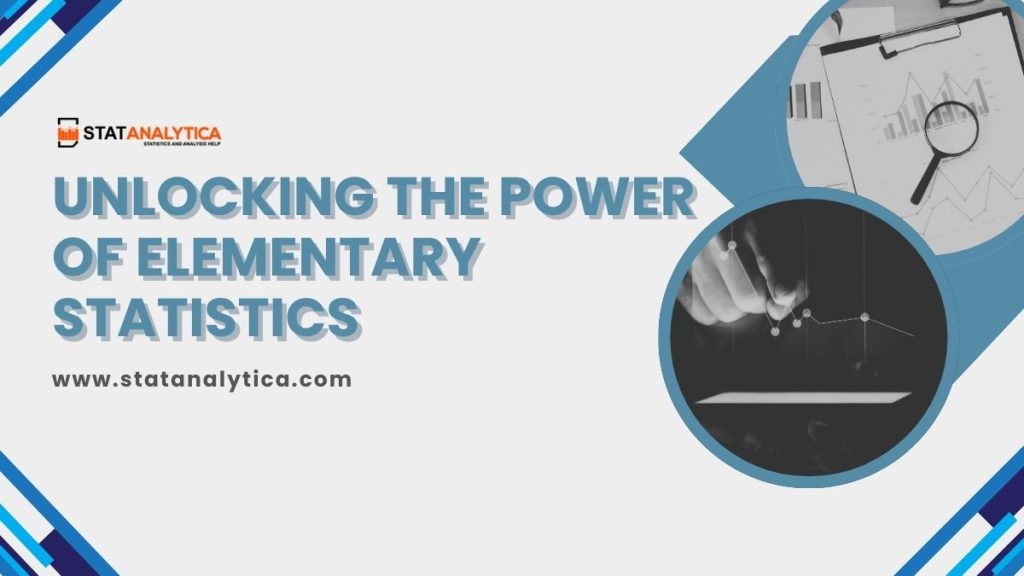Elementary statistics is a foundational aspect of understanding data in our increasingly data-driven world. This branch of statistics provides critical tools for interpreting, analyzing, and making informed decisions using numerical data. Despite its significance, many people harbor misconceptions about statistics, often viewing it as overly complicated or irrelevant to their everyday lives.
Today’s blog aims to demystify elementary statistics, highlighting its importance and practical applications in various fields. By the end of this guide, readers will appreciate the power of elementary statistics and how it can enhance personal and professional growth.
What is Elementary Statistics?
Table of Contents
Elementary statistics refers to the basic concepts and techniques used for collecting, analyzing, and interpreting data. It is fundamentally about understanding information to help individuals and organizations make informed decisions and identify trends. A key distinction is between descriptive statistics, which summarizes data using measures like mean, median, and mode, and inferential statistics, which allows for predictions and generalizations about a population based on a sample.
Elementary statistics plays a significant role in daily life, enabling informed choices in various contexts, from sports to health data. For instance, understanding clinical trial data helps individuals evaluate new medications effectively. Mastering elementary statistics empowers people to navigate a data-driven world successfully.
Key Concepts in Elementary Statistics
Data Types
Understanding data types is essential in elementary statistics. Data can be divided into two categories: qualitative and quantitative. Qualitative data, also known as categorical data, describes characteristics or attributes such as color or name. In contrast, quantitative data refers to numerical values that can be measured, such as age or height. Recognizing the distinction between these data types allows statisticians to select appropriate analytical techniques.
Within quantitative data, there is further classification between continuous and discrete data. Continuous data can take any value within a given range, such as temperature or height, while discrete data represents distinct, separate values, like the number of students in a class. A thorough understanding of data types is required for accurate statistical analysis.
Descriptive Statistics
Descriptive statistics are extremely useful for summarising and organizing data. The mean, median, and mode are all important central tendency measures. The mean represents a dataset’s average and provides a quick snapshot of overall performance. The median, or the middle value in an ordered dataset, is useful for understanding data distribution, especially in skewed datasets. The mode, or most frequently occurring value, aids in the identification of data trends.
In addition to measures of central tendency, measures of variability provide insight into data dispersion. The range, which measures the difference between the highest and lowest values, offers a basic understanding of spread. Variance and standard deviation delve deeper into data variability, quantifying how much individual data points differ from the mean. These descriptive statistics form the foundation for more complex analyses, making them essential in elementary statistics.
Probability Basics
Probability is the foundation of statistical inference, allowing statisticians to predict future events based on previous data. A basic understanding of probability is essential in elementary statistics. Probability is defined as the likelihood of an event occurring, expressed as a number between 0 and one. A probability of zero indicates that the event cannot occur, whereas a probability of one indicates that it will almost certainly occur.
Basic probability rules, such as addition and multiplication, guide statistical analysis. According to the addition rule, the probability of any two mutually exclusive events occurring is equal to the sum of their probabilities. In contrast, the multiplication rule calculates the probability of two independent events occurring at the same time. A solid understanding of these fundamental principles provides students with the tools they need to investigate more complex statistical concepts.
Importance of Elementary Statistics in Various Fields
Business and Economics
Elementary statistics plays a vital role in business and economics, influencing decision-making processes across various sectors. Companies rely on statistical analysis to evaluate market trends, understand consumer behavior, and forecast sales. By analyzing data, businesses can make informed decisions about product development, pricing strategies, and marketing campaigns. Additionally, elementary statistics aids economists in studying economic indicators, allowing them to interpret data effectively and shape policies that promote economic growth.
Health and Medicine
Elementary statistics is critical in health and medicine for determining the efficacy of treatments and interventions. Medical professionals use statistical analysis to interpret clinical trial results, ensuring that new medications or procedures are safe and effective. Understanding the statistical significance of a study’s findings, for example, assists practitioners in determining whether the results can be applied to a larger population. Furthermore, elementary statistics contribute to public health initiatives by analyzing disease prevalence trends and assessing the effectiveness of health policies.
Education
Elementary statistics is instrumental in the education sector, guiding curriculum development and assessment strategies. Educators utilize statistical analysis to evaluate student performance, identify areas for improvement, and measure the effectiveness of teaching methods. Standardized tests, which are often analyzed using statistical techniques, provide valuable insights into student learning and achievement. By harnessing the power of elementary statistics, educators can enhance the learning experience for their students and foster better educational outcomes.
Social Sciences
Elementary statistics are heavily used in the social sciences to analyze human behavior and societal trends. Researchers in psychology, sociology, and political science use statistical techniques to examine relationships between variables and draw conclusions about human behavior. By analyzing survey data or observations, social scientists can identify patterns and correlations that can inform public policy and social programs. Elementary statistics provides insights that contribute to a better understanding of societal dynamics.
Tools and Techniques for Elementary Statistics
Statistical Tools
With the advent of technology, various statistical tools have emerged to facilitate data analysis. Software applications such as Microsoft Excel, SPSS, and R provide powerful platforms for conducting statistical analyses. Excel, for example, offers basic statistical functions and visualization tools that are accessible to beginners. SPSS is widely used in social sciences, providing advanced statistical techniques for complex data analysis. R, a programming language, is favored by statisticians for its flexibility and comprehensive statistical capabilities.
Common Statistical Techniques
In addition to statistical tools, several common statistical techniques are essential for data analysis. T-tests, for instance, compare the means of two groups to determine if there is a significant difference between them. Chi-square tests assess the relationship between categorical variables, providing insights into associations within the data. Understanding these techniques is vital for conducting meaningful analyses and drawing accurate conclusions from data.
How to Learn and Master Elementary Statistics
Recommended Resources
Learning elementary statistics can be a rewarding endeavor, and numerous resources are available to facilitate this journey. Books like “Statistics for Dummies” and “Naked Statistics” provide straightforward introductions to statistical concepts. Online courses on platforms like Coursera and edX provide structured learning experiences with expert instructors. Additionally, free tutorials on websites like Khan Academy make it easy for beginners to grasp fundamental concepts at their own pace.
Tips for Effective Studying
To master elementary statistics, learners should adopt effective study habits. Regular practice is essential, as statistics is best understood through application. Working with real datasets can enhance comprehension and reinforce concepts. Collaborating with peers or joining study groups can also provide valuable insights and support. Furthermore, engaging with statistical software can help build confidence in data analysis.
Real-World Applications
Understanding the real-world applications of elementary statistics is crucial for grasping its significance. Exploring case studies and practical examples helps learners appreciate the value of statistical analysis. Whether analyzing sports performance, evaluating marketing campaigns, or interpreting health data, the ability to apply elementary statistics in real-world scenarios enhances learning and retention.
Conclusion
In conclusion, mastering elementary statistics is a valuable skill that empowers individuals to make informed decisions based on data. This guide has explored the fundamental concepts, key applications, and essential tools in elementary statistics.
By understanding the importance of statistical analysis in various fields, readers can appreciate the power of elementary statistics in their personal and professional lives.
As data continues to shape our world, embracing elementary statistics opens doors to new opportunities for growth and understanding. Readers are encouraged to explore further, practice their skills, and unlock the full potential of elementary statistics.
FAQs
How is elementary statistics different from advanced statistics?
Elementary statistics focuses on fundamental concepts and methods, while advanced statistics involves more complex techniques and analyses.
Why is understanding elementary statistics important?
Understanding elementary statistics is crucial for making informed decisions based on data in various fields such as business, health, and education.


